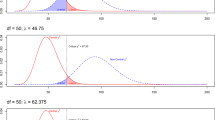Abstract
Parametric stochastic frontier models yield firm-level conditional distributions of inefficiency that are truncated normal. Given these distributions, how should one assess and rank firm-level efficiency? This study compares the techniques of estimating (a) the conditional mean of inefficiency and (b) probabilities that firms are most or least efficient. Monte Carlo experiments suggest that the efficiency probabilities are easier to estimate (less noisy) in terms of mean absolute percent error when inefficiency has large variation across firms. Along the way we tackle some interesting problems associated with simulating and assessing estimator performance in the stochastic frontier model.
Similar content being viewed by others
Notes
This has been accomplished in the semi-parametric, fixed-effect specification of the stochastic frontier, using the theory of multiple comparisons. See Horrace and Schmidt (2000).
Since large n, small T is typical in panel datasets, perhaps time-invariant technical inefficiency is the empirically relevant case. In what follows we only consider the time-invariant case.
The question of “how precisely \(\widehat{\theta }_{j}\) estimates u j ?” is interesting, but it not addressed here.
For example, Feng and Horrace (forthcoming) consider the effects of the skewness of the technical inefficiency distribution on various technical efficiency estimates.
There is a price one pays when selecting a subsample based on some external rule. That is, the firms with a similar characteristic (e.g. large size) may have a different technology from those firms that do not have the characteristic. Empiricists may select or group the firms from the sample based on some rule, but different groups may have different technologies.
This is particularly difficult to predict for the efficiency probabilities.
We omitted n = 500, T = 20 to save computing time for the entire exercise.
We could have allowed the x jtm to be correlated within firms but did not.
When CGLS fails due to \(\hat{\sigma}_{u}^{2}<0, \) we set \(\hat{\sigma}_{u}^{2}=0, \) per Waldman (1982).
We also calculated mean absolute error for each measure, but the results were similar to those for MSE and are not reported.
The imprecision may be worsen by the fact that the fixed effects estimator cannot exploit correlations between x and u, as they have not been built into the DGP.
Of course there is no way to disentangle this phenomenon from the effect of the random effects estimator approaching the fixed effects estimator, but it is interesting to note.
References
Aigner DJ, Lovell CAK, Schmidt P (1977) Formulation and estimation of stochastic frontier production functions. J Econom 6:21–37
Baltagi BH (2005) Econometric analysis panel data. Wiley, New York
Battese GE, Coelli TJ (1988) Prediction of firm-level technical efficiencies with a generalized frontier production function and panel data. J Econom 38:387–399
Battese GE, Coelli TJ (1992) Frontier production functions, technical efficiency and panel data: with application to paddy farmers in India. J Prod Anal 3:153–170
Bera AK, Sharma SC (1999) Estimating production uncertainty in stochastic frontier models. J Prod Anal 12:187–210
Cuesta RA (2000) A production model with firm-specific temporal variation in technical efficiency: with application to Spanish dairy farms. J Prod Anal 13:139–158
Feng Q, Horrace WC (Forthcoming) Alternative technical efficiency measures: skew, bias and scale. J Appl Econom
Greene WH (2005) Reconsidering heterogeneity in panel data estimators of the stochastic frontier model. J Econom 126:269–303
Horrace WC (2005) On ranking and selection from independent truncated normal distributions. J Econom 126:335–354
Horrace WC, Schmidt P (1996) Confidence statements for efficiency estimates from stochastic frontier models. J Prod Anal 7:257–282
Horrace WC, Schmidt P (2000) Multiple comparisons with the best, with economic applications. J Appl Econom 15:1–26
Jondrow J, Lovell CAK, Materov IS, Schmidt P (1982) On the estimation of technical efficiency in the stochastic production function model. J Econom 19:233–238
Hsiao C (1986) The analysis of panel data. Cambridge University Press, Cambridge
Kumbhakar SC (1990) Production frontiers, panel data, and time-varying technical inefficiency. J Econom 46:201–211
Meeusen W, van den Broeck J (1977) Efficiency estimation from Cobb-Douglas production functions with composed error. Intl Econ Rev 18:435–444
Olson JA, Schmidt P, Waldman DM (1980) A Monte Carlo study of estimators of stochastic frontier production functions. J Econom 13:67–82
Simar L, Wilson PW (2009) Inferences from cross-sectional, stochastic frontier models. Econom Rev 29:62–98
Waldman D (1982) A stationary point for the stochastic frontier likelihood. J Econom 18:275–279
Author information
Authors and Affiliations
Corresponding author
Rights and permissions
About this article
Cite this article
Horrace, W.C., Richards-Shubik, S. A Monte Carlo study of ranked efficiency estimates from frontier models. J Prod Anal 38, 155–165 (2012). https://doi.org/10.1007/s11123-011-0238-y
Published:
Issue Date:
DOI: https://doi.org/10.1007/s11123-011-0238-y




